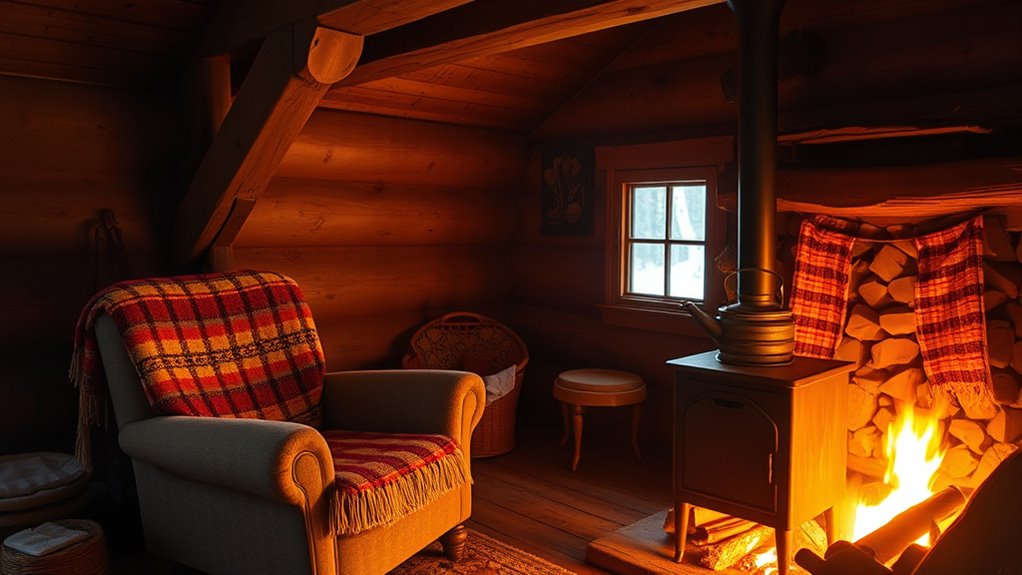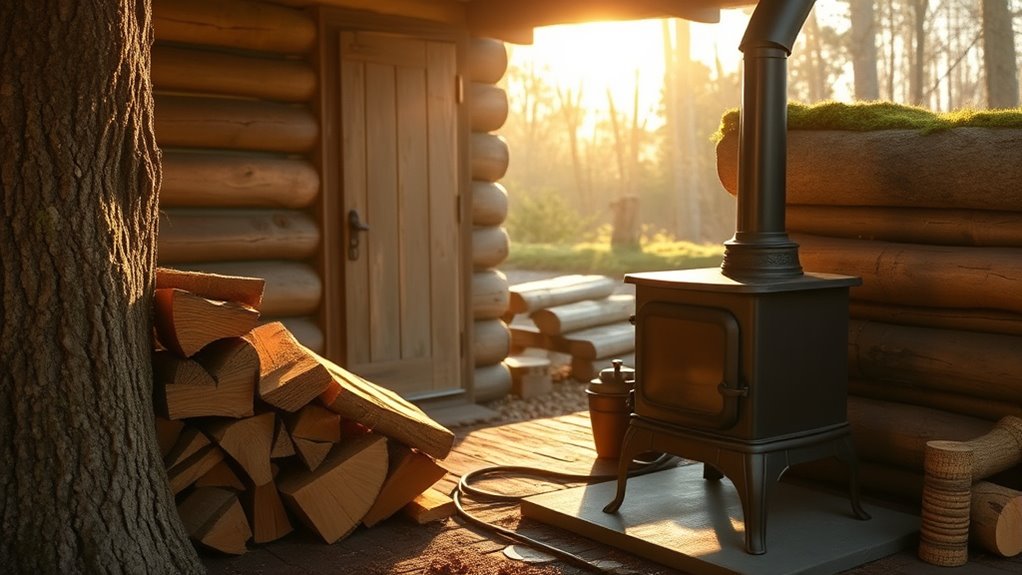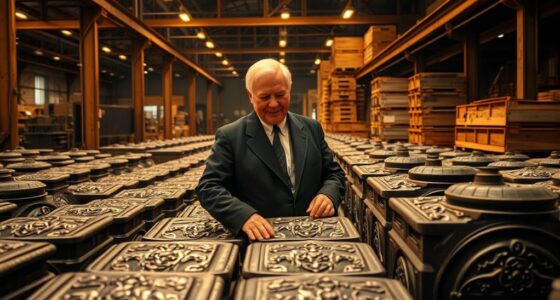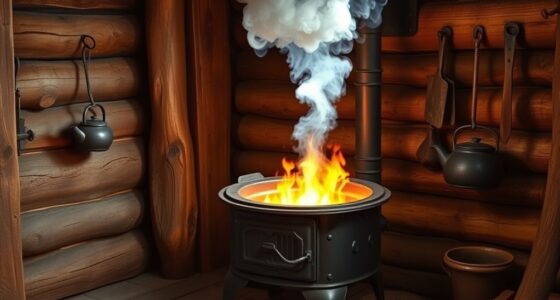You’ll find that traditional wood heating has been a cornerstone for off-grid homesteads, relying on simple, durable designs like brick fireplaces and wood stoves. These methods emphasize resourcefulness, using local materials and centuries-old techniques to keep homes warm efficiently. They prioritize sustainable practices, focusing on complete combustion and proper insulation. If you explore further, you’ll discover how these historical approaches can inspire reliable, eco-friendly heating solutions tailored to off-grid living.
Key Takeaways
- Traditional wood heating methods have historically provided reliable warmth for off-grid communities worldwide.
- Evolving from open fires to efficient wood stoves, these techniques emphasize resourcefulness and multifunctionality.
- Cultural practices prioritize durable materials, craftsmanship, and sustainable resource use in heating solutions.
- Historic heating methods reflect a deep connection to local environments and natural materials.
- These traditions continue to influence modern off-grid homesteading with sustainable, low-energy heating approaches.

Have you ever wondered how off-grid homesteads keep warm during cold months without relying on electricity or centralized heating systems? The answer often lies in traditional, time-tested methods that have sustained communities for centuries. Wood stove efficiency plays a pivotal role here, as it determines how effectively you can convert wood into heat, maximizing warmth while conserving resources. Historically, heating methods relied heavily on simple, durable designs that harnessed natural materials and principles of insulation. These historic heating methods, from large brick fireplaces to small potbelly stoves, were built to last and adapt to local climates, providing reliable warmth with minimal energy input.
Traditional heating methods and efficient wood stoves have kept off-grid homesteads warm for centuries.
In many traditional homesteads, the centerpiece was the wood stove, a device that evolved from rudimentary open fires to sophisticated, efficient appliances. Historically, these stoves didn’t just heat a room—they often served multiple purposes, including cooking, bathing, and even drying clothes. The design emphasized heat retention and distribution, with thick cast iron or steel bodies that radiated warmth over time. Improving wood stove efficiency means paying attention to airflow, proper insulation, and combustion quality. Properly seasoned wood, a key aspect of historic heating methods, ensures a cleaner, more efficient burn, reducing emissions and maximizing heat output.
You can learn from these old techniques by ensuring your stove is well-maintained, with a clean chimney and good airflow. Many historic heating methods also employed strategic placement of stoves in central locations of the home to evenly distribute heat. Using insulation materials like thick curtains, rugs, or even double-pane windows helps trap warmth, a practice rooted in the old ways of keeping homes cozy. The core principle remains the same: make the most of your fuel by burning it as completely and efficiently as possible. Additionally, understanding the importance of self-sufficiency in historic heating practices can inspire modern off-grid solutions that rely less on external energy sources.
Even in modern times, the charm and resilience of historic heating methods inspire those who live off-grid. Embracing these methods means understanding that warmth isn’t just about technology; it’s about resourcefulness, craftsmanship, and respect for natural materials. By focusing on wood stove efficiency and drawing lessons from historic heating practices, you can create a warm, sustainable home that honors traditional wisdom while meeting contemporary needs. Whether you’re upgrading an old stove or installing a new one, applying these principles helps you maintain a cozy homestead through even the coldest seasons.
Frequently Asked Questions
How Did Early Homesteaders Source Their Firewood Sustainably?
You likely sourced firewood sustainably by practicing forest management, which involves selective cutting and leaving younger trees intact. This approach helps maintain a healthy forest ecosystem and guarantees continuous wood harvests. Early homesteaders understood wood harvest sustainability by avoiding overharvesting and allowing the forest to regenerate naturally. They balanced their needs with environmental stewardship, ensuring their firewood supplies lasted for generations without damaging the surrounding woodland.
What Cultural Traditions Influenced Wood Heating Practices Historically?
Think of your wood stove as a bridge connecting past and present. Historically, cultural traditions like medieval hearths emphasized communal warmth and ritual, shaping how people used fire. Indigenous fire rituals, rooted in spiritual connections with nature, influenced respectful and sustainable wood use. These practices fostered a deep respect for fire’s power, guiding early homesteaders to honor tradition and nature while keeping their homes warm.
How Did Regional Climates Shape Wood Heating Techniques Worldwide?
You’ll notice that climate adaptation and regional architecture heavily influence wood heating techniques worldwide. In colder regions, you might use thick stone walls and airtight stoves to maximize heat retention, while warmer climates favor open hearths and ventilation for cooling. These techniques evolve to suit local climates, ensuring comfort and efficiency. Your understanding of regional architecture helps you appreciate how communities tailor their wood heating practices to their environment.
What Role Did Community Sharing Play in Wood Fuel Supply?
Imagine a world where communal reliance on shared resources kept your homestead warm. You’d participate in community firewood gatherings, trading or lending fuel to neighbors in need. This system fostered cooperation, ensuring everyone had enough wood during harsh winters. Sharing fuel strengthened bonds and created a resilient network, proving that collective effort was essential for survival in off-grid living. Such cooperation made wood heating more sustainable and accessible for all.
How Have Wood Heating Methods Evolved With Technological Advancements?
You’ve seen how wood heating methods have evolved with modern heating innovations like efficient stoves and automated systems. These advancements reduce ecological impacts by improving burn efficiency and lowering emissions. You now benefit from cleaner, more sustainable options that conserve resources and minimize environmental harm. As technology progresses, your off-grid homestead can enjoy reliable warmth while supporting ecological balance, making traditional wood heating more effective and environmentally friendly.
Conclusion
As you consider the rich history of wood heating, you realize it’s more than just a practical choice—it’s a connection to generations past. But as modern challenges grow, will this age-old tradition survive, or fade into memory? The answer isn’t clear yet. One thing’s certain: the future of off-grid homesteads could hinge on whether we embrace the warmth of tradition or let it slip away. The next chapter is waiting to be written.











